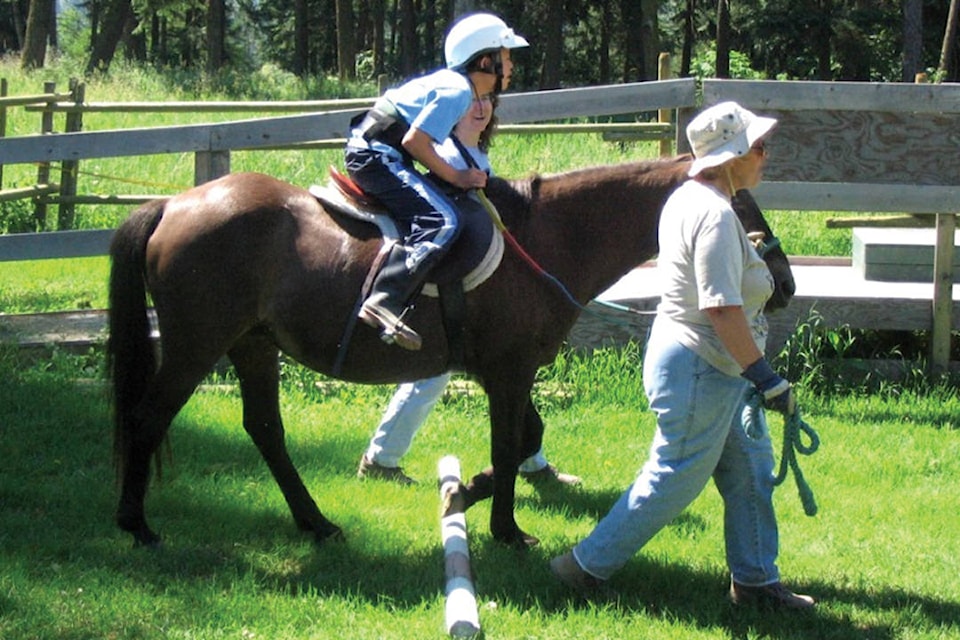CRESTON-KOOTENAY FOUNDATION
In the 15th anniversary year of CDSCL’s Therapeutic Riding Program (TRP), program director Michelle Whiteaway is building a legacy. This year, the organization is starting its own endowed fund with the Creston-Kootenay Foundation (CKF).
A link between the two organizations was established from the early days: Alex and Nicole Nilsson were with CKF from the beginning, and were also star volunteers at TRP.
“Alex told me ‘You should ask for a little bit of money,’ ” Whiteaway said of her first grant application to the foundation. “But over the years, it’s helped a lot.”
Since 2005, expenses have crept up by about 40 per cent. The six riders who accessed services in the first year have grown to 92 individual riders taking lessons in 2019.
“If we didn’t fundraise, solicit donations and write grants, we would have to charge $90 a lesson,” said Whiteaway. “I look for that extra $60-plus for every lesson so that we can make the program accessible for people who can benefit.”
Whiteaway hopes that the new endowed fund will be part of the solution, generating investment income for the program from a principal amount that remains intact and will hopefully grow over the years.
“Endowments are a way of looking further ahead for non-profits,” said CKF president Ted Hutchinson. “Rather than solving today’s problem, they solve future problems. Growing an endowment takes some of the pressure off volunteers and staff.”
“If we start now, and plant that seed, we might attract other people to help it grow,” said Whiteaway. “I want that financial freedom for the next generation. And we want our fund with the Creston-Kootenay Foundation, because they have an excellent reputation and vision. It’s something that will be here for a long time, like we plan to be.”
When Whiteaway attended the 2019 conference of the Professional Association of Therapeutic Horsemanship, sustainability and succession planning were at the forefront of discussions. Many therapeutic riding programs don’t last longer than seven years. Programs driven by their founders often don’t outlive the founder’s departure.
That could have easily happened in Creston, with the burnout of TRP’s former director. In July 2008, Sarah Schmidt advised the organization of her departure, set up everything for an easy administrative transition, and moved on the following month. Whiteaway learned a great deal from the experience.
“Sarah did everything and was everything,” she said. “When she left, her job was taken on by three people and we shared the load.”
Every year, TRP beats the odds through a combination of the right people at the right time. Whiteaway, who at 12 dreamed of horses, became a software engineer and honed her project management and problem-solving skills. She was able to meticulously plan her escape from work within two years of reading Creston’s name on her Kokanee beer’s label while vacationing in Clark Fork, Idaho. She joined TRP in March 2006, when the program boasted only a tack room shed and passionate volunteers.
Before Schmidt left, she was able to find Christine Ross, “talk her into becoming head instructor, thank God,” and recruit Judine Maki as public riding instructor. Whiteaway took over running the program, and started working on her own training qualifications and living the dream (occasionally without a paycheque).
That dream is based on juggling hard numbers. It costs the program about $132,000 a year to operate, a number kept low through a strong co-operative relationship with Spectrum Farms. For the 2018-2019 fiscal year, TRP paid $68,846 for wages, mandatory employer-related costs and benefits for one full-time and five part-time employees. A direct access Community Gaming Grant helped cover $46,000 of the costs. Lessons are made possible by 10 horses, an army of volunteers (47 at last count, 20 who regularly help with lessons) and organization support under the umbrella of the Creston and District Society for Community Living.
That leaves Whiteaway with about $70,000 to fundraise every year. Recently, another B.C. therapeutic riding program was forced by circumstances to cancel a fall session. Whiteaway is determined that will never happen on her watch. When she retires, her mobile home on-site will accompany the job to make TRP a more attractive employer and add to the organization’s stability.
“Therapeutic riding has no reserve fund. We’re all about programs, and funding for existing programs is very limited,” she said. “We need money every year and we have some very loyal, dedicated supporters. But you’re always chasing your tail if you don’t do something.”
